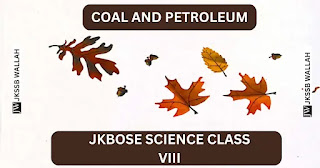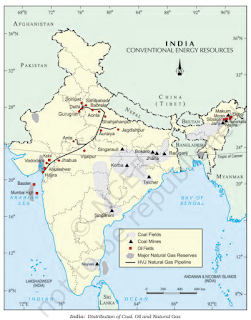
Q.1 What are the advantages of using CNG and LPG as fuels?
Ans: Advantages of CNG and LPG as fuels:
- Direct Combustion: They can be burned directly for energy.
- Easy Transportation: They can be easily transported through pipelines.
- Clean Fuels: They burn cleanly and do not produce smoke.
- High Heat Output: They provide a lot of heat energy when burned.
These qualities make CNG and LPG efficient and environmentally friendly fuel options.
2. Name the petroleum product used for surfacing of roads.
Ans: Bitumen is a thick, black petroleum product used to make strong, smooth road surfaces.
3. Describe how coal is formed from dead vegetation. What is this process called?
Ans: Millions of years ago, dense forests were buried under soil due to natural events like storms and floods. Over time, layers of soil compressed them under high pressure and temperature, gradually turning them into coal. This process of forming coal from dead plants is called carbonization.
Q4. Fill in the banks.
(b) Process of separation of different constituents from petroleum is called refining
(c) Least polluting fuel for vehicles is compressed natural gas (CNG).
Q5.Tick True/False against the following statements.
Ans:(a) Fossil fuels can be made in the laboratory. (F)
(b) CNG is more polluting fuel than petrol. (F)
(c) Coke is an almost pure form of carbon. (T)
(d) Coal tar is a mixture of various substances. (T)
(e) Kerosene is not a fossil fuel. (F)
Q6. Explain why fossil fuels are exhaustible natural resources.
Ans: Fossil fuels take millions of years to form from dead plants and animals buried deep in the Earth. They need high temperature and pressure, which we can’t create in a lab. This means fossil fuels are limited, and if we keep using them quickly, they will eventually run out.
Q7. Describe the characteristics and uses of coke.
Ans: Characteristics of Coke:
– Hard, porous, and high in carbon.
– Burns cleanly with little smoke.
Uses of Coke:
– Fuel in industries.
– Steel production.
– Water purification.
– Making chemicals like calcium carbide.
Q8. Explain the process of the formation of petroleum.
Ans: Petroleum was formed from dead organisms buried in the sea millions of years ago. These remains were covered by layers of sand and clay. Over time, the lack of air, along with high temperature and pressure, transformed them into petroleum and natural gas.
Q9.The following table shows the total power shortage in India from 1991−1997. Show the data in the form of a graph. Plot shortage percentage for the years on the Y-axis and the year on the X-axis.
| S. No. | Year | Shortage (%) |
|---|---|---|
| 1 | 1991 | 7.9 |
| 2 | 1992 | 7.8 |
| 3 | 1993 | 8.3 |
| 4 | 1994 | 7.4 |
| 5 | 1995 | 7.1 |
| 6 | 1996 | 9.2 |
| 7 | 1997 | 11.5 |
Ans:

Q10. What are exhaustible natural resources?
Ans: Exhaustible Natural Resources are natural resources that can run out because they are limited. If we use them too much or waste them, they won’t last long. Some examples include:
Wildlife
Minerals
Coal
Petroleum
Natural Gas
These resources are valuable, so it’s important to use them wisely.
Q11. What are inexhaustible natural resources?
Ans: Inexhaustible Natural Resources are resources that are available in unlimited quantities and won’t run out, even with human use. Examples include:
– Sunlight
– Air
Q12. Why natural gas is called a clean fuel?
Ans: Natural gas is a clean fuel because it produces less pollution than other fossil fuels. It can be easily transported through pipelines and is used for:
- – Fueling vehicles
- – Heating homes
- – Powering factories
These features make it a more environmentally friendly energy source.
Q13. What are the uses of coal?
Ans: Coal is a black, hard substance that has various uses:
- – It was once used in railway engines to produce steam.
- – Now, it’s commonly used for cooking food.
- – It powers thermal power plants to generate electricity.
- – It serves as fuel in various industries.
Despite its usefulness, coal can contribute to pollution when burned.
Extended Learning-Activities and Projects
1. Get an outline map of India. Mark the places in the map where coal, petroleum and natural gas are found. Show the places where petroleum refineries are situated.
- Major Coal Deposits:
Odisha: Talcher, Ib Valley.
West Bengal: Raniganj.
Chhattisgarh: Korba.
Madhya Pradesh: Singrauli.
- Major Petroleum and Natural Gas Reserves:
Gujarat: Ankleshwar, Cambay, and Kalol.
Assam: Digboi, Naharkatiya, and Moran.
Andhra Pradesh: Krishna-Godavari Basin.
- Petroleum Refineries:
Chennai: Chennai Petroleum Corporation Limited (CPCL).
Mangalore: Mangalore Refinery and Petrochemicals Limited (MRPL).
Assam: Digboi, Guwahati, and Numaligarh refineries.
Gujarat: Jamnagar (Reliance and Essar refineries), Vadodara.
Bihar: Barauni.
Uttar Pradesh: Mathura.
Haryana: Panipat.

2. Choose any five families of your neighbourhood. Enquire whether their energy consumption (coal, gas, electricity, petrol, kerosene) has increased or decreased in the last five years. Enquire also about the measures they adopt
| Family | Energy Type | Consumption Trend | Conservation Measures | Overall Consumption Trend |
|---|---|---|---|---|
| Family 1 | Coal | Decrease | Limited use due to environmental awareness. | Mostly decreased for coal and kerosene, increased for gas and electricity. |
| Gas | Increase | Cooks efficiently using a pressure cooker. | ||
| Electricity | Increase | Uses LED bulbs and energy-efficient appliances. | ||
| Petrol | No Change | Carpooling to reduce petrol usage. | ||
| Kerosene | Decrease | Stopped using kerosene; shifted to LPG. | ||
| Family 2 | Coal | No Change | Rarely used; no conservation measure needed. | Decreased for kerosene; increased for gas and electricity. |
| Gas | Increase | Uses solar water heating to save gas. | ||
| Electricity | Increase | Reduces usage of heating/cooling appliances. | ||
| Petrol | No Change | Walks for short distances; saves petrol. | ||
| Kerosene | Decrease | Minimal usage, relies more on gas. | ||
| Family 3 | Coal | No Change | Not used; no conservation measures needed. | Decreased for kerosene; increased for gas, electricity, and petrol. |
| Gas | Increase | Maintains cooking efficiency, limits gas usage. | ||
| Electricity | Increase | Turns off lights/appliances when not in use. | ||
| Petrol | Increase | Uses public transport to reduce petrol consumption. | ||
| Kerosene | Decrease | No longer used; shifted to other energy sources. | ||
| Family 4 | Coal | No Change | Minimizes use as much as possible. | Decreased for kerosene; increased for gas, electricity, and petrol. |
| Gas | Increase | Efficient cooking methods to save gas. | ||
| Electricity | Increase | Uses energy-efficient lighting and appliances. | ||
| Petrol | Increase | Uses carpool or ridesharing options. | ||
| Kerosene | Decrease | Phased out in favor of LPG. | ||
| Family 5 | Coal | No Change | Only used occasionally, not a primary fuel source. | Mostly increased for gas, electricity, and petrol; no change for kerosene and coal. |
| Gas | Increase | Ensures full use of fuel in each cooking session. | ||
| Electricity | Increase | LED lighting, limits air conditioning use. | ||
| Petrol | Increase | Combines trips to reduce fuel consumption. | ||
| Kerosene | No Change | Rarely used, primarily depends on LPG. |
3. Find out the location of major thermal power plants in India. What could be the reasons for their being located at those places?
Major Thermal Power Plants in India
- Vindhyachal Thermal Power Station
Location: Madhya Pradesh
Capacity: 4,760 MW
- Sasangir Thermal Power Plant
Capacity: 1,000 MW
- Mundra Thermal Power Station
Capacity: 4,000 MW
- Talcher Super Thermal Power Station
Capacity: 3,000 MW
- Kahalgaon Thermal Power Station
Capacity: 1,320 MW
- Sipat Thermal Power Station
Capacity: 2,980 MW
- Rajasthan Rajya Vidyut Utpadan Nigam Limited (RRVUNL)
Capacity: 1,560 MW
- Nellore Thermal Power Station
Capacity: 1,320 MW
Reasons for Location
- Proximity to Fuel: Located near coal mines for easy access to fuel.
- Water Supply:
